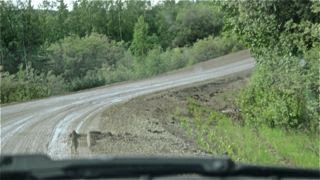Following the Pipeline
 There were so many quick changes in the pavement and the weather, it was really hard to cope. There were squalls that you could see coming, like on the ocean, and they would open up and pour, and then the next stretch of road would be dry. The hills were steep and winding.
There were so many quick changes in the pavement and the weather, it was really hard to cope. There were squalls that you could see coming, like on the ocean, and they would open up and pour, and then the next stretch of road would be dry. The hills were steep and winding. When you reached the crest of a hill, the nose of the truck would be pointed skyward with no sense of what was over the crest. Likewise, once you crested, you still couldn’t see the bottom of the hill.
We stopped and looked at a vista point where a tremendous fire called the Hess Fire had burned over 50,000 acres. Most of these fires are lightening strikes. I believe this fire occurred in 1991, so almost 20 years later, regrowth is slow.
The hills through here are covered with birch primarily, with some black and white spruce and aspen. They are really pretty, and the light plays on them through the clouds. There were a lot of ruts caused by these quick rains and the best place to be was in the middle of the road, as long as a truck wasn’t coming.
We followed the pipeline almost the whole way, which makes sense because the road was built for the construction of the pipeline. It is high off the ground, but dips under the highway or below the ground in places. There are small pieces of equipment at the top of each of the side bars, which takes any heat away from the pipeline and send it upward to protect the permafrost. The migratory patterns of various animals, particularly the caribou were taken into consideration, and the pipe goes underground in those areas.
It is also insulated to withstand extreme temperatures from 100 above freezing, to eighty below.





















No comments:
Post a Comment